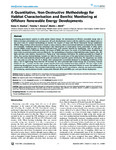A Quantitative, Non-Destructive Methodology for Habitat Characterisation and Benthic Monitoring at Offshore Renewable Energy Developments
| dc.contributor.author | Sheehan, Emma | |
| dc.contributor.author | Stevens, TF | |
| dc.contributor.author | Attrill, Martin | |
| dc.date.accessioned | 2017-04-27T13:19:47Z | |
| dc.date.available | 2017-04-27T13:19:47Z | |
| dc.date.issued | 2010-12-29 | |
| dc.identifier.issn | 1932-6203 | |
| dc.identifier.issn | 1932-6203 | |
| dc.identifier.other | ARTN e14461 | |
| dc.identifier.uri | http://hdl.handle.net/10026.1/9149 | |
| dc.description.abstract |
Following governments' policies to tackle global climate change, the development of offshore renewable energy sites is likely to increase substantially over coming years. All such developments interact with the seabed to some degree and so a key need exists for suitable methodology to monitor the impacts of large-scale Marine Renewable Energy Installations (MREIs). Many of these will be situated on mixed or rocky substrata, where conventional methods to characterise the habitat are unsuitable. Traditional destructive sampling is also inappropriate in conservation terms, particularly as safety zones around (MREIs) could function as Marine Protected Areas, with positive benefits for biodiversity. Here we describe a technique developed to effectively monitor the impact of MREIs and report the results of its field testing, enabling large areas to be surveyed accurately and cost-effectively. The methodology is based on a high-definition video camera, plus LED lights and laser scale markers, mounted on a "flying array" that maintains itself above the seabed grounded by a length of chain, thus causing minimal damage. Samples are taken by slow-speed tows of the gear behind a boat (200 m transects). The HD video and randomly selected frame grabs are analysed to quantify species distribution. The equipment was tested over two years in Lyme Bay, UK (25 m depth), then subsequently successfully deployed in demanding conditions at the deep (>50 m) high-energy Wave Hub site off Cornwall, UK, and a potential tidal stream energy site in Guernsey, Channel Islands (1.5 ms⁻¹ current), the first time remote samples from such a habitat have been achieved. The next stage in the monitoring development process is described, involving the use of Remote Operated Vehicles to survey the seabed post-deployment of MREI devices. The complete methodology provides the first quantitative, relatively non-destructive method for monitoring mixed-substrate benthic communities beneath MPAs and MREIs pre- and post-device deployment. | |
| dc.format.extent | e14461-e14461 | |
| dc.format.medium | Electronic | |
| dc.language | en | |
| dc.language.iso | eng | |
| dc.publisher | Public Library of Science (PLoS) | |
| dc.subject | Animals | |
| dc.subject | Biodiversity | |
| dc.subject | Conservation of Energy Resources | |
| dc.subject | Cost-Benefit Analysis | |
| dc.subject | Ecosystem | |
| dc.subject | Energy-Generating Resources | |
| dc.subject | Environmental Monitoring | |
| dc.subject | Equipment Design | |
| dc.subject | Fishes | |
| dc.subject | Geologic Sediments | |
| dc.subject | Invertebrates | |
| dc.subject | Lighting | |
| dc.subject | Oceans and Seas | |
| dc.subject | United Kingdom | |
| dc.title | A Quantitative, Non-Destructive Methodology for Habitat Characterisation and Benthic Monitoring at Offshore Renewable Energy Developments | |
| dc.type | journal-article | |
| dc.type | Journal Article | |
| dc.type | Research Support, Non-U.S. Gov't | |
| plymouth.author-url | https://www.webofscience.com/api/gateway?GWVersion=2&SrcApp=PARTNER_APP&SrcAuth=LinksAMR&KeyUT=WOS:000285793200014&DestLinkType=FullRecord&DestApp=ALL_WOS&UsrCustomerID=11bb513d99f797142bcfeffcc58ea008 | |
| plymouth.issue | 12 | |
| plymouth.volume | 5 | |
| plymouth.publication-status | Published online | |
| plymouth.journal | PLoS ONE | |
| dc.identifier.doi | 10.1371/journal.pone.0014461 | |
| plymouth.organisational-group | /Plymouth | |
| plymouth.organisational-group | /Plymouth/Faculty of Science and Engineering | |
| plymouth.organisational-group | /Plymouth/Faculty of Science and Engineering/School of Biological and Marine Sciences | |
| plymouth.organisational-group | /Plymouth/PRIMaRE Publications | |
| plymouth.organisational-group | /Plymouth/REF 2021 Researchers by UoA | |
| plymouth.organisational-group | /Plymouth/REF 2021 Researchers by UoA/UoA07 Earth Systems and Environmental Sciences | |
| plymouth.organisational-group | /Plymouth/Users by role | |
| plymouth.organisational-group | /Plymouth/Users by role/Academics | |
| dc.publisher.place | United States | |
| dcterms.dateAccepted | 2010-12-10 | |
| dc.identifier.eissn | 1932-6203 | |
| dc.rights.embargoperiod | Not known | |
| rioxxterms.versionofrecord | 10.1371/journal.pone.0014461 | |
| rioxxterms.licenseref.uri | http://www.rioxx.net/licenses/all-rights-reserved | |
| rioxxterms.licenseref.startdate | 2010-12-29 | |
| rioxxterms.type | Journal Article/Review |


